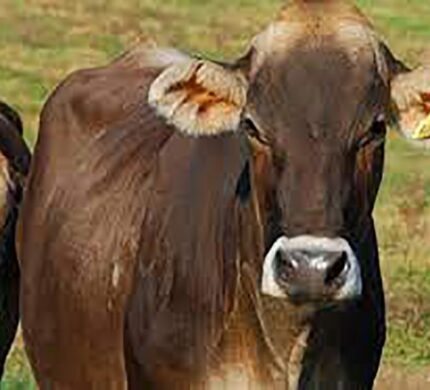Brown Swiss Cattle
- Temperature:101.5 to 103.5 degrees F
- Milk:1,800 to 3,000 gallons per year
- Food:Hay, Pasture grasses and Silage
- Pregnancy:283 days or nine months
- Nationality:Switzerland

General Information
Brown Swiss cattle have a distinctive appearance, with a medium to large frame and a solid, muscular build. They are typically a shade of brown or gray, and they have large, floppy ears and a slightly convex profile.
Brown Swiss cattle are a medium to large breed of cattle. Mature cows typically weigh between 1,000 to 1,500 pounds, while mature bulls can weigh between 1,800 to 2,500 pounds.
Brown Swiss cattle are known for their docile and friendly temperament, which makes them easy to handle and manage. They are also adaptable to a wide range of environmental conditions and management practices.
Brown Swiss cattle have a long history that dates back to the Alpine region of Switzerland. The breed has been widely distributed around the world and has been further developed and adapted to local conditions in many different countries.
Where we find this cow to buy?
Brown Swiss cattle are a popular breed of cattle, and they can be found for sale in many countries around the world. The availability of Brown Swiss cattle will depend on your location and local breeding practices. Here are some ways you can find Brown Swiss cattle for sale:
01. Local classified ads : You can check local newspapers or classified ads to see if Brown Swiss cattle are being sold in your area.02. Livestock auctions : Livestock auctions are a common way to buy and sell cattle. You can check local listings for livestock auctions and attend to see if Brown Swiss cattle are being sold.03. Online Marketplaces : Brown Swiss cattle can be found on online marketplaces such as Craigslist, Facebook Marketplace, and breed-specific websites.04. Cattle breeders and associations : Contact local cattle breeders or associations to inquire about Brown Swiss cattle availability.

How to increase milk production in Brown Swiss Cattle?
There are several ways to increase milk production in Brown Swiss cattle:
01
Consult with a veterinarian or animal nutritionist to develop a feeding program to increase milk production.
02
Sheep management can increase milk production by providing a comfortable barn environment.
03
Eating cows with a history of high milk production and breeding them with high-producing bulls can improve milk production.
04
Milking more frequently and using proper milking technique, including complete udder emptying, can help increase milk yield.
Medicine
There are several medicines and treatments that may be used for Brown Swiss cattle to prevent or treat various diseases and conditions. Here are some common medicines and treatments that may be used for Brown Swiss cattle:
01
AntibioticsAntibiotics are used to treat bacterial infections in cattle, but must be followed to avoid milk and meat residues.
02
Anti-inflammatory DrugsNSAIDs can reduce inflammation and pain associated with mastitis and lameness.
03
Reproductive HormonesProstaglandins and gonadotropins regulate estrous cycle and improve fertility in cows.
04
Parasite ControlProducts are available to control parasites in Brown Swiss cattle, such as anthelmintics and insecticides.
Pregnancy
Brown Swiss cattle are a breed of dairy cattle that can become pregnant through natural mating or artificial insemination. The gestation period for Brown Swiss cattle is typically around 280 to 290 days, or approximately nine months. The exact length of gestation can vary depending on factors such as the age and health of the cow, the breeding method used, and environmental conditions.
During pregnancy, Brown Swiss cattle require appropriate nutrition and care to support the growth and development of the calf and maintain the health of the mother. This includes providing adequate feed, clean water, and proper veterinary care. It is also important to monitor the cow for any signs of illness or complications during pregnancy.
Provide proper care and nutrition to ensure the calf’s health and wellbeing, including colostrum, vaccinations, and monitoring for any signs of illness or health issues.
Food
Brown Swiss cattle, like all cattle, require a well-balanced diet that meets their nutritional needs for maintenance, growth, and reproduction. Here are some foods that are commonly fed to Brown Swiss cattle:
Hay and silage are the most common types of forage fed to Brown Swiss cattle, providing fiber and essential nutrients.
Brown Swiss cattle are often fed grains to provide additional energy and protein. Common grains include corn, soybeans, and barley.
Cattle may be given supplements to ensure they receive vitamins and minerals, such as calcium, phosphorus, magnesium, and trace minerals.
Clean and fresh water is essential for the health and well-being of Brown Swiss cattle. They require access to an adequate supply of water at all times.
Facts
Brown Swiss cattle are a breed of dual-purpose cattle that originated in the Simme Valley of Switzerland. Here are some facts about Brown Swiss cattle:
They are a popular breed for use in cheese production, with their milk being prized for its high butterfat and protein content.
Brown Swiss cattle have a distinctive coat color ranging from light brown to dark brown, and can appear almost black in some individuals.
Brown Swiss cattle have been shown to have superior udder health, with a lower incidence of mastitis compared to other dairy breeds.
Brown Swiss cows are known for their high milk production, with some individuals producing up to 10 gallons of milk per day.
They are a hardy breed that is well-suited to a variety of climates and environmental conditions.
Brown Swiss cattle are a dual-purpose breed, meaning they are used for both milk and beef production.
Brown Swiss cattle have been used to improve the milk production and hardiness of other cattle breeds.
They are a large breed, with bulls weighing up to 2,500 pounds and cows weighing up to 1,800 pounds.